Preferred temperature (Ref.
115969): 24.8 - 29.3, mean 28.4 (based on 1923 cells).
Fylogenetische diversiteitsindex (Ref.
82804): PD
50 = 0.5000 [Uniqueness, from 0.5 = low to 2.0 = high].
Bayesian length-weight: a=0.01445 (0.01199 - 0.01742), b=3.03 (2.98 - 3.08), in cm Total Length, based on LWR estimates for this species (Ref.
93245).
Weerstandsvermogen (Ref.
120179): laag, minimale populatieverdubbelingstijd 4,5-14 jaar (tmax=14; k=0.22).
Fishing Vulnerability (Ref.
59153): Moderate to high vulnerability (48 of 100).
